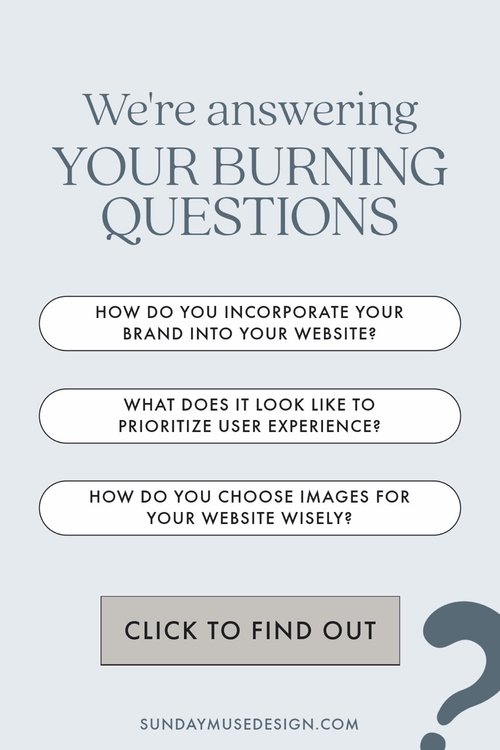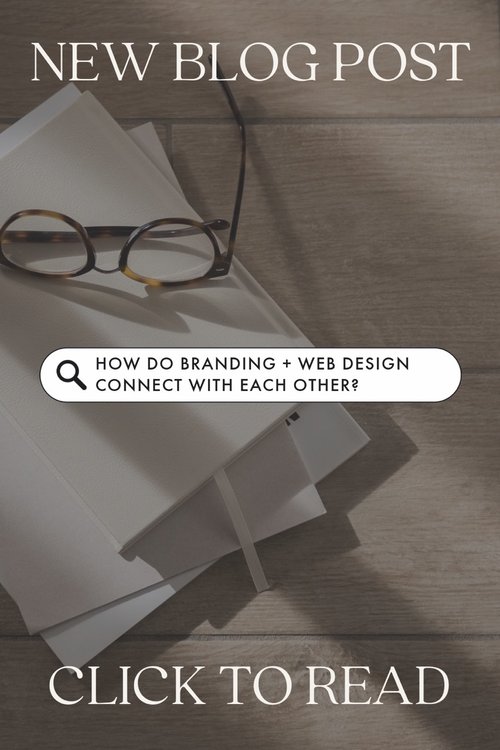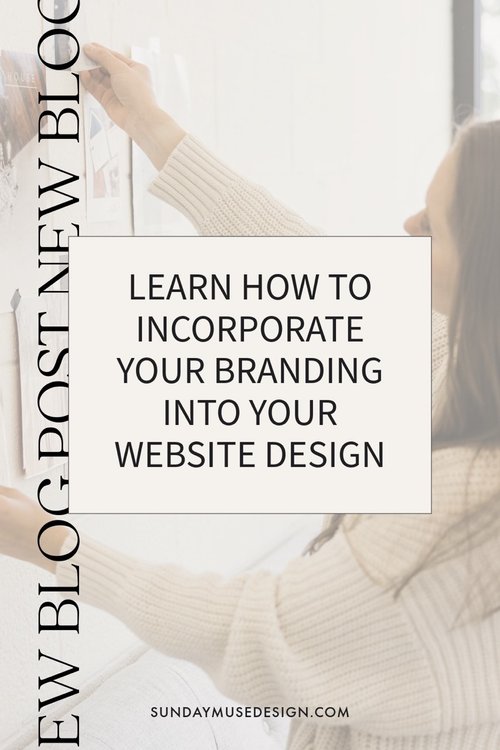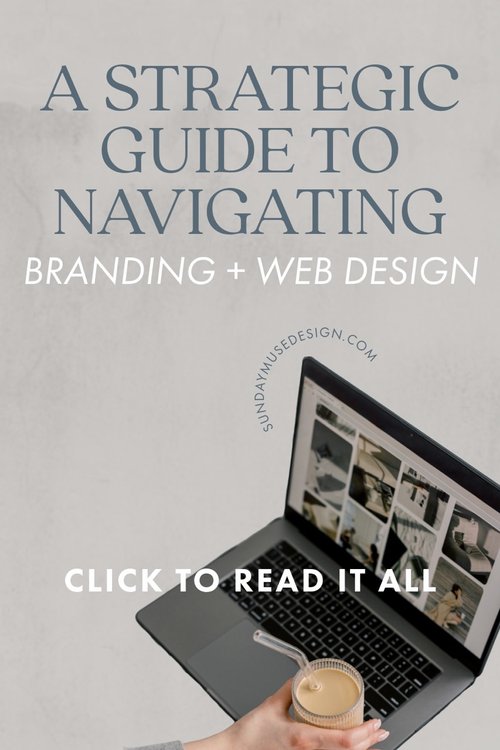Navigating the Intersection of Branding and Web Design: A Strategic Guide
Branding and web design are more important than ever for creatives and other small businesses looking to establish a strong online presence. A well-designed website not only showcases a brand's visual identity but also helps build recognition and trust among consumers. However, combining branding and web design can be...er, challenging to say the least... and requires a super strategic approach that aligns branding elements with the functionality and user experience of a website.
This comprehensive guide delves into the intricacies of combining branding and web design to create a cohesive and compelling online presence. We're also going to explore how to use your brand's unique voice and personality to create a website that reflects your values and resonates with your target audience. Whether you're a small business owner or a seasoned marketer, this guide offers valuable insights and practical tips to help you navigate the complex world of branding and web design.
Get ready to learn how to marry branding and web design to create a visually stunning and user-friendly website that not only grabs attention and leaves a lasting impact on visitors.... but helps convert them into actual buyers. (because that's the whole point...right?)
And if you haven’t grabbed the free Brand Strategy Workbook yet, be sure to grab it!
Understanding branding and web design
Branding is a crucial aspect of web design that helps differentiate one company from its competitors. It encompasses a combination of a company's name, logo, design, and overall image.
But it doesn't stop there.
Branding also represents a brand's values, personality, and promise to its customers.
On the other hand, web design refers to the visual and functional aspects of a website, such as its layout, color scheme, typography, and navigation.
The importance of a cohesive brand identity
Having a consistent brand identity is crucial for building a strong and memorable online presence. It ensures that all visual elements of your brand, such as your logo, color scheme, typography, and imagery, work together cohesively to create a recognizable brand experience. Doing so can help establish trust and credibility among your website visitors, as they can easily identify and connect with your brand across different touchpoints.
Through a holistic brand strategy process, your visual identity can actually evolve into a purposeful narrative.
Elements of effective web design
Effective web design is not just about the way a website looks—it also involves various elements that contribute to a positive user experience. These elements include intuitive navigation, fast loading times, mobile responsiveness, and accessibility. By prioritizing user-friendly design, you can ensure that your website is easy to navigate, and visitors can find the information they need quickly. Additionally, incorporating visual hierarchy, clear call-to-actions, and engaging content can enhance the overall user experience and encourage visitors to stay longer on your site.
You may also be interested in reading 6+ Tips to Engage Users and Get More Inquiries on Your Website.
The role of branding in web design
Branding is an essential aspect of web design and it allows you to distinguish yourself from your competitors and establish a distinct identity. (No one wants to blend in, right?) Web designers can utilize brand elements such as logos, colors, fonts, and imagery to infuse your website with your brand's personality and values. This helps to create a seamless and memorable user experience that aligns with your overall positioning and messaging. Additionally, consistent use of branding elements across your website reinforces brand recognition and cultivates a sense of trust and familiarity among your users.
Creating a brand-focused web design strategy
To develop a web design strategy that is focused on your brand, you'll want to align the visual elements of the website with your brand's core values and target audience. You want to start with a brand strategy.
The first step is to define your unique voice and personality. This includes identifying the key messages and emotions that you want to convey. By doing so, you can create a solid foundation for designing a website that effectively reflects and communicates your brand's essence.
It's also important to conduct thorough research on your target audience's preferences and behaviors. This can help inform design decisions and ensure that your website resonates with your intended users.
The impact of web design on brand perception
The design of a website has a significant impact on how a brand is perceived by its audience. A well-designed website that aligns with a brand's identity and values can enhance brand perception and create a positive impression. In contrast, a poorly designed website can cause frustration, confusion, and a negative perception of the brand. OOF.
Consistency in design, user-friendly navigation, and attention to detail are crucial in shaping the overall perception of a brand through its website.
Incorporating brand elements into web design
So how do you tactically integrate your brand strategy into the web design process?
Here are some actionable steps you may want to take:
Integrate your brand elements consistently and across every touchpoint: Make sure your logo, colors, and fonts are prominently and consistently displayed on all pages.
Logo Placement: Strategically place your logo in a prominent but non-intrusive position. Ensure it's consistently visible across all pages.
Color Palette: Use your brand's color palette consistently. Colors evoke emotions and contribute to brand recognition. Apply them to buttons, backgrounds, and other design elements.
Typography and Fonts: Choose fonts that align with your brand personality. Consistent typography across your website reinforces brand identity. Your fonts, by the way, should be easy to read while reflecting your brand's personality.
Customized Forms: If your website includes forms, PLEASE customize them with your brand colors and fonts. I see too many small businesses forgetting to make sure their CRM contact forms are branded. And make sure the language you're using on your contact forms aligns with your brand voice.
Choose images and graphics wisely: All of your images should align with your brand identity. They should be professional photos... high quality... using the same lighting and editing techniques. Honestly - photos taken by your brother on his phone aren't going to scream "I'm a professional!" The images you choose should also evoke the emotion you want to convey. An editorial, dark image of someone walking through a room conveys a verrrrrrry different tone and emotion than a light, airy photo of someone sitting on the beach.
Brand Imagery: Use images that reflect your brand's values and messaging. Whether it's product shots, team photos, or lifestyle images, they should align with your brand narrative.
Visual Storytelling: Leverage visual storytelling by incorporating images that convey a narrative. This could be the journey of your products, behind-the-scenes glimpses, or success stories.
Be sure your brand messaging is crystal clear and your tone is consistent. If you don't already have a Brand Style Guide that includes brand voice descriptors, I highly encourage you to look into that. Then share that guide with your web designer!
Taglines and Headlines: Craft taglines and headlines that resonate with your brand voice.
About Us Page: Use the About Us page to tell your brand story. Include the mission, values, and history of your brand, creating a connection with visitors. Hmmm...check out this post for more ideas for your About Page!
Consistent Tone: Maintain a consistent tone throughout your website. If your brand voice is casual and friendly, ensure that reflects in your web copy.
Humanize Your Brand: Use relatable language that resonates with your target audience. Avoid jargon unless it's part of your brand persona.
Integrate interactive features and pay attention to emerging trends: Don't be afraid of adding some interactive design elements and subtle trends to your website. Parallalax scrolling, sticky sections that "stick" when you scroll through your site, and button hover animations are some microanimations to try. You could also add a chatbot or make your website immersive by inviting your visitor on a journey.
Prioritize user experience by focusing on intuitive navigation, fast loading times, accessibility, and mobile responsiveness.
Intuitive Navigation: Design a user-friendly navigation structure. Visitors should easily find what they're looking for. Align navigation labels with your brand language.
Engaging CTAs: Craft compelling calls-to-action (CTAs) using language consistent with your brand. Whether it's "Shop Now" or "Discover More," align CTAs with your brand message.
Thank You Pages: After form submissions, redirect users to a branded thank-you page. This reinforces your brand and provides a positive post-interaction experience.
Inclusive Language: Use language that is inclusive and welcoming. Ensure that your brand voice is considerate of diverse audiences.
Accessible Design: Design your website to be accessible to all users. This inclusivity reflects positively on your brand personality.
And don't forget to regularly update and maintain your website to keep it fresh and in line with evolving brand strategies!
By seamlessly incorporating these elements, you can create a consistent brand experience that leaves a lasting impression on visitors.
And there you have it—a pretty thorough look at harmonizing your brand and website design!
Your website isn't just a digital space; it's your brand's online haven. It's your online storefront. By fusing the art of branding with the science of web design, you're not just creating a website; you're crafting an experience.
This isn't just theory or smoke & mirrors; this is your roadmap to a digital revolution to elevate your online presence.
So, armed with these insights and tips, go update your website. Or hire someone to help you. Tweak those visuals, and let your brand's voice serenade your audience. Go ahead, weave the story of your brand into every click, scroll, and interaction.










